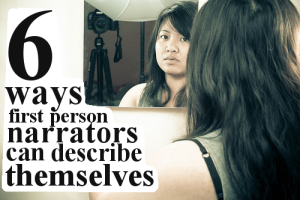If your main character is narrating the story, how do they describe themselves? You could just start in “I have long blonde hair and blue eyes,” but somehow it feels like the next part should be “and I like long walks on the beach.”
It’s awkward for a reason: normal people don’t walk around reminding themselves of their own hair color, eye color and height.
That’s why the mirror is such a bad cliché. I don’t know about you, but when I look in the mirror, I’m not thinking “I have brown hair and brown eyes,” I’m thinking “Man, my teeth are really starting to look coffee stained. I need to do a serious peroxide rinse.”
So unless your protagonist is surveying the results of his face transplant, try one of these alternatives.
1. Don’t describe him at all
Do your readers have to know what the protagonist looks like to understand the plot? If not, consider leaving it out altogether. After all, you want your reader to look through the hero’s eyes, not at them.
Especially if your character is only “average-looking.” Average-ness implies itself and need not be explained. That’s like saying water is wet.
2. Give it to your reader straight
This one is dependant on the style of narration. If you are actually telling the story to someone (with frequent quirky asides to your “dear reader”), rather than telling a story that someone else just happens to read, your hero can simply describe himself during introductions. But be warned: don’t try to force it if this isn’t your style.
3. Embarrass them
Make them self-conscious about a physical flaw. She only smiles close-mouthed because she’s embarrassed by the gap in her teeth. He wishes he had biceps like the head jock.
If you want to get all the important details in at once, have someone super good looking stare at them, to make them extra aware of all their flaws, like John Green does when The Fault in Our Stars protagonist Hazel notices hot boy Augustus is staring at her in their cancer support group, and she thinks about her jeans that sag in weird places, unbrushed pageboy haircut, and ridiculously fat chipmunked cheeks – a side effect of chemo. A laundry list, but the thought flow is logical and natural.
4. Compare and contrast with another character
“My daughter has my crooked smile, but her father’s blue eyes.” or, “We were the strangest pair you’ve ever seen. I was tall and stringy, he was short and pudgy. Standing next to each other, we looked like a lowercase ‘b.’ Or ‘d,’ depending on who was on which side.” These can even create a poetic effect, as you can simultaneously compare and contrast personality traits as well.
5. Use dialogue
Her best friend gently explains dark roots are out of fashion. His father remarks he really ought to cut his hair (he looks like a hippie). Her enemy asks if she’s a natural redhead. Use compliments (“I with I had your thighs!”) and nicknames (Shorty, Stringbean, Pineapple Head).
6. Show, don’t tell
Don’t try to describe the character all at once, but little by little, showing, not telling. If they are short, have them struggle to reach something most others could get. If tall, have them duck through doorways. If they are unattractive, make them self-conscious around people of the opposite sex. If attractive, have others flirt with them. This is a figurative mirror – your hero’s appearance is reflected in the way other characters react to it.
—
How do you describe your narrator? Tell us in the comments!
—

Describe your main character without the tired old “looking in the mirror” cliche.



